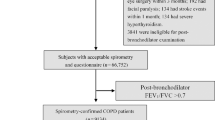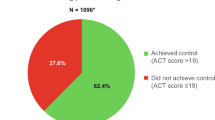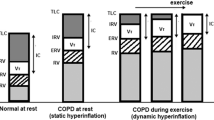Abstract
Clinical scenario
A 55 year-old cleaner attends for the third time this year with an exacerbation of her COPD. She has an increased cough, productive of clear sputum and breathlessness, with scattered rhonchi in the chest and an oxygen saturation level of 96%. She knows from experience that it will be at least 10 days before she is back to normal, and requests a medical certificate to be absent from work. She normally recovers well, and although she is always breathless on more strenuous exercise, she is not otherwise troubled by her symptoms which are eased sufficiently by her short-acting β2-agonist. She therefore stopped the inhaled corticosteroid/long-acting β2-agonist (ICS/LABA) prescribed after a previous exacerbation. Spirometry last year showed an FEV1/FVC ratio of 0.58 and a post-bronchodilator FEV1 of 47% predicted. She still smokes about 15 cigarettes a day.
Similar content being viewed by others
Assessment
We would start by asking for details about her two main symptoms of cough and dyspnoea and checking that she had no general symptoms of fever. On examination, if there was no evidence of respiratory distress or concomitant conditions that could worsen the exacerbation, no more investigations would be considered at this time. The diagnosis of an exacerbation relies on the clinical presentation of an acute change of symptoms that is beyond normal day-to-day variation.1,2 In summary, our patient has a moderate exacerbation of her known COPD, characterised by moderate airflow limitation and frequent exacerbations. She is not compliant with the previously prescribed medications for the stable condition.
Management of the exacerbation
Current guideline management of the exacerbation is based on the severity of the exacerbation1,2 and the likelihood of infectious aetiology based on Anthonisen criteria.3 More than 80% of exacerbations can be managed in an outpatient setting. She is normally prescribed a short course of oral corticosteroids for her wheeze, and is recommended to increase her short-acting bronchodilators. Antibiotics would be indicated if her sputum becomes purulent.1 Early review after 72 hours is important to check that she has improved, to advise her when to reduce the emergency treatment, and to recommence maintenance therapy with a combination inhaled corticosteroid/long-acting β2-agonist (ICS/LABA) inhaler.
Routine follow-up and maintenance treatment
We would plan another scheduled visit four weeks later to reassess our patient in a stable condition. Even though previously she has not been motivated to stop smoking, we will again encourage her to consider a quit attempt and offer support from our practice ‘stop smoking’ group. Her past history suggests that she usually recovers well, with minimal dyspnoea (mMRC score = 2), and it is likely that she will again decide to discontinue regular inhaled medication a few weeks after the exacerbation.
The GOLD 2011 update recommends carrying out a multidimensional evaluation,1 which — in addition to the severity of airway obstruction — also considers exacerbation frequency, symptoms (especially dyspnoea), and a broader assessment of the impact of COPD measured with a validated tool such as the COPD Assessment Test (CAT).4,5 According to this new approach, the patient belongs to category C: few on-going symptoms but at high risk of exacerbations (see Figure 1 in Gruffydd-Jones's summary of the GOLD 2011 update.6
Why is she having so many exacerbations?
Patients who have two or more exacerbations a year are defined as ‘frequent exacerbators’.7 Exacerbations of COPD can be precipitated by several factors,1,2 but the most common cause is respiratory infections. Air pollution and other causes of inflammation can trigger increased wheeze. The presence of bronchiectasis or chronic bacterial colonisation in COPD patients could promote repeated infected exacerbations, and investigations such as sputum cultures, chest X-ray or high resolution CT scanning might be indicated. In our patient, the non-purulent sputum and previously good response to treatment with oral corticosteroids with no need of antibiotics seems to rule out infection or bronchiectasis.
Our patient has few symptoms between exacerbations, and one possibility is that she has a component of asthmatic bronchial hyper-reactivity generating the frequent exacerbations. About 15% of COPD patients are asthma patients who have smoked and developed incompletely reversible airflow obstruction,8 or smokers without a known history of asthma but with a predominantly eosinophilic inflammatory pattern. These patients may be described as “mixed COPD-asthma phenotype”.
The new Spanish COPD guidelines recognise these patients as an additional phenotype (illustrated in Figure 1) with clinical, prognostic and treatment response differences.2
Mixed COPD-asthma phenotype
A Spanish expert group has proposed some criteria (not yet validated) for the diagnosis of the mixed phenotype: two major or one major and two minor criteria are required for the diagnosis (see Table 1).
According to the GesEPOC classification, our patient has a significant impairment of respiratory function and frequent exacerbations (at least three in the last year), with a good response to oral steroids, raising the suspicion that she could have a mixed COPD-asthma phenotype. However, we need to review the history, and undertake further investigations to confirm the diagnosis. Asking about a personal history of asthma or atopy, the history of previous exacerbations, frequency and intensity of coughing, is important. Repeated reversibility tests should be performed during the follow-up to detect airflow obstruction variability. A blood sample to look for total immunoglobulin E levels may be helpful. A referral to a secondary care specialist for induced sputum eosinophilia or a measurement of the fraction of exhaled nitric oxide (FeNO) could also be helpful if the diagnosis is still not clear.
Management of mixed COPD-asthma
Patients with the mixed phenotype share clinical and inflammatory features with asthma, characterised by a good response to steroids, though smoking reduces the effectiveness of ICS — which could be one of the reasons for our patient's poor compliance. We should avoid monotherapy with a LABA, and prescribe a combination ICS/LABA therapy even in mild or moderate COPD.
Although she has previously been prescribed an ICS/LABA combination inhaler, she stopped treatment after a few weeks. Education to help her understand the importance of regular treatment in reducing the frequency of exacerbations and the need for time off work, will be crucial to gaining control of the disease. It is also important that she recognises early signs of an exacerbation and the prompt action she can take. We must recommend basic measures such as annual flu vaccination, proper nutrition, regular exercise and, of course, stopping smoking. We should develop a specific individual intervention explaining the significance that continued smoking has on the long term evolution of COPD and the effectiveness of the ICS treatment, offering all possible resources to help her with this difficult task.
References
Global Initiative for Chronic Obstructive Lung Disease (GOLD). Global Strategy for the Diagnosis, Management and Prevention of COPD. Updated December 2011 Available from: http://www.goldcopd.org (Accessed August 2012)
Miravitlles M, Soler-Cataluña JJ, Calle M, et al. Spanish COPD Guidelines (GesEPOC): Pharmacological Treatment of Stable COPD. Arch Bronconeumol 2012;48:247–57. http://dx.doi.org/10.1016/j.arbr.2012.05.003
Anthonisen NR, Manfreda J, Warren CPW et al. Antibiotic-therapy in exacerbations of chronic obstructive pulmonary disease. Ann Intern Med 1987;106:196–204.
Jones P, Harding G, Berry P, Wiklund I, Chen W-H, Leidy N . Development and first validation of the COPD Assessment Test. Eur Respir J 2009;34:648–54. http://dx.doi.org/10.1183/09031936.00102509
Jones P, Harding G, Wiklund I, Berry P, Leidy N . Improving the process and outcome of care in COPD: development of a standardised assessment tool. Prim Care Resp J 2009;18:208–15. http://dx.doi.org/10.4104/pcrj.2009.00053
Gruffydd-Jones K . GOLD guidelines 2011: what are the implications for primary care? Prim Care Respir J 2012;21(4):437–41. http://dx.doi.org/10.4104/pcrj.2012.00058
Hurst JR, Vestbo J, Anzueto A, et al. Susceptibility to exacerbation in chronic obstructive pulmonary disease. N Eng J Med 2010;363:1128–38. http://dx.doi.org/10.1056/NEJMoa0909883
Hardin M, Silverman EK, Barr RG, et al. COPDGene investigators. The clinical features of the overlap between COPD and asthma. Respir Research 2011;12:127. http://dx.doi.org/10.1186/1465-9921-12-127
Acknowledgements
Handling editor Hilary Pinnock
Author information
Authors and Affiliations
Corresponding author
Ethics declarations
Competing interests
The authors declare that they have no conflicts of interest in relation to this article. Jesus Molina was one of the main authors of the Spanish COPD guidelines GesEPOC, and Miguel Roman was one of the reviewers of the document.
Rights and permissions
About this article
Cite this article
Molina, J., Román Rodríguez, M. How I would manage a woman with COPD with few symptoms but at high risk of an exacerbation: a primary care perspective from Spain. Prim Care Respir J 21, 446–448 (2012). https://doi.org/10.4104/pcrj.2012.00099
Received:
Accepted:
Published:
Issue Date:
DOI: https://doi.org/10.4104/pcrj.2012.00099




